#european common cuttlefish
Text
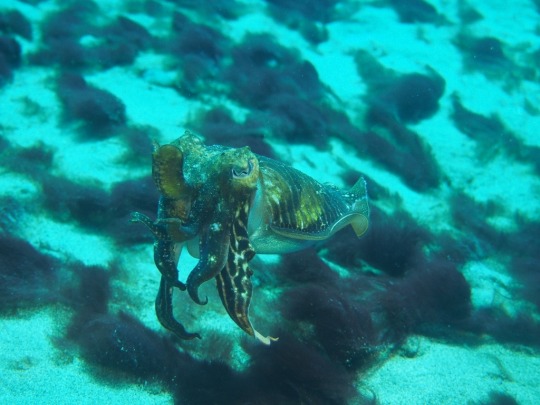
Daily Cephalopod #73
#cuttlefish#european common cuttlefish#sepia officinalis#daily cephalopod#cephalopod#cephalopods#marine life#ocean creatures#ocean critters#marine biology#zoology#animals#biology#marine animals#marine critters#marine creatures#ocean animals
220 notes
·
View notes
Photo
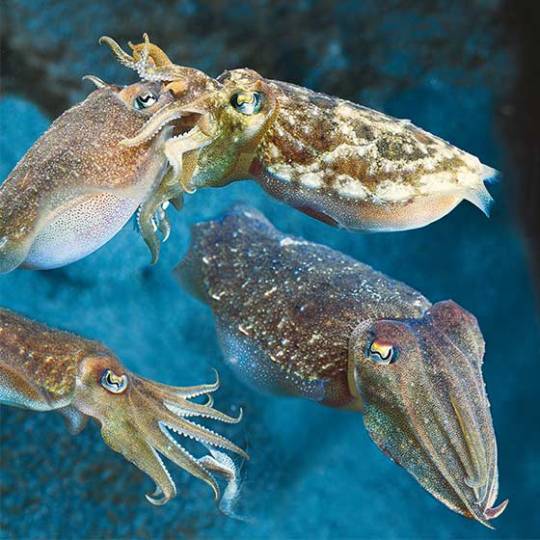

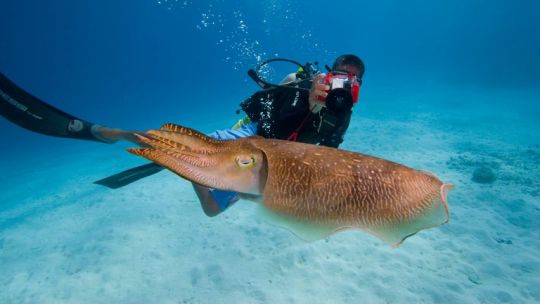
The common cuttlefish also known as the European cuttlefish or the European common cuttlefish is one of the largest and best-known cuttlefish species from the genus sepia. It is native to the waters of the North Atlantic and the Mediterranean, North, and Baltic Seas. They are a migratory species that spend the summer and spring in shallow inshore waters (sometimes even brackish estuaries) for spawning and then move to depths of 330 to 650ft (100 to 200m) during autumn and winter. Common cuttlefish tend to spend there days resting underneath sandy/ muddy substrate and emerge at night to hunt prey such as shrimp, small fish, crabs, clams, and snails. Common cuttlefish are themselves preyed upon by sharks, larger boney fish, seals, dolphins, porpoises, octopi, squid, and other cuttlefish. They have many defensive mechanisms to help protect them from predators including a siphon which they can use to shoot water out of to propel them at high speeds away from danger, ink which can distract and disorient a predator as the cuttlefish escapes, and their camouflage abilities which can help them avoid predators altogether. Reaching nearly 3ft (90cms) in length the common cuttlefish is amongst the largest species of cuttlefish. They have an internal cuttlebone, often washing up on beaches and used to supplement the diet of pet birds. The cuttlebone assists in buoyancy. The common cuttlefish has two highly developed eyes, eight arms which are located around the mouth and are used to hold and move objects, and a pair of feeding tentacles, longer and thinner than the others, that are normally hidden from sight. Like many cephalopods, their skin is covered in chromatophores, special coloured cells that can stretch and contract to allow the cuttlefish to rapidly change colour. The colours created reflect the health and mood of the cuttlefish, and special patterns and colours are used in courtship and to startle predators. Breeding occurs during the spring and summer in shallow waters, male cuttlefish will display a black and white zebra pattern on their mantle to attract females and females will display a uniform grey colour to indicate they are ready to mate. Around 30 to 90 days after mating the mother Cuttlefish will lay 100 to 1000 eggs and attach them to seaweed, shells, or other substrates to prevent them from drifting away and have ink deposits on them to aid in camouflage. Under ideal conditions a common cuttlefish will reach sexual maturity at 14 and 18 months of age and may live just 2 years.
13 notes
·
View notes
Text
I am currently at the beach and this has gotten me thinking about Mermay, and I had some thoughts on what type of aquatic animals each of the TF2 mercs (plus Pauling, Admin, and Saxton Hale) would be. Here are my ideas so far:
Scout - Fourwing Flying fish
Soldier - Bull Shark
Pyro - Weedy Seadragon
Demoman - Black Marlin or Porcupine Pufferfish
Heavy - Beluga Whale
Engineer - Hardhead Catfish
Medic - Giant Moray Eel
Sniper - Common Lionfish or Banded Archerfish
Spy - European Common Cuttlefish
Miss Pauling - Sea Angel or Dumbo Octopus
The Administrator - Australian Box Jellyfish
Saxton Hale - Orca
(Might draw a couple of these sometime in the future if I have time!)
#tf2#tf2 mermay#team fortress 2#tf2 spy#tf2 medic#tf2 sniper#tf2 scout#tf2 demoman#tf2 soldier#tf2 heavy#tf2 engineer#tf2 pyro#ramblings#death-by-moth
24 notes
·
View notes
Text
Thulhuu: Kwami of Horror
Name: Thulhuu
Gender: Male
Aspect: Horror
Animal Form: European Common Cuttlefish
Color, Green, Red and Yellow
Miraculous Iteam: Carved Cuttlebone Cameo Brooch
Miracle Box: Atlantean Miracle Box (Father Box)
Owner: N/A
Transformation Phrase: Thulhuu! Time to SCREAM!!!
Detransformation Phrase: waits dreaming
History: He is the Kwami of Horror, the one who dreams nightmares and is scared of his own shadow. Thulhuu is one of the Kwami of the Atlantean Miracle Box, which was lost with the Destruction of Atlantis, only to end up with Juleka Couffaine, who is a bit of a Lovecraft Fan.
#miraculous ladybug#father box au#original miraculous#original kwami#juleka couffaine#Ph'nglui mglw'nafh Cthulhu R'lyeh wgah'nagl fhtagn
4 notes
·
View notes
Text
Activity 2: Billingsgate Fish Market & Borough Market
Part 1: Billingsgate Fish Market
Grey Mullet is an oily fish and bottom feeder, which can give it a negative reputation of tasting fishy or muddy, but as long as it is fresh it makes an inexpensive and delicious protein. Because of its oiliness, it is more forgiving of being overcooked and it can hold its own against flavourful sauces, just pay attention to its many small bones. Recipe: https://www.greatbritishchefs.com/recipes/pan-fried-grey-mullet-recipe

2. Whelks are sea snails that have been a traditionally important food in many seaside European areas. In Britain they are often served boiled, in a vinegar dressing or with butter, as a sort of bar snack, whereas in France and Spain they are typically served with aioli. In both Portugal and Korea they are canned. However, they don’t have to be served plain, they can also be stir fried or battered for something different. Recipe: https://www.lovenorwichfood.co.uk/recipe/sherry-battered-whelks/.
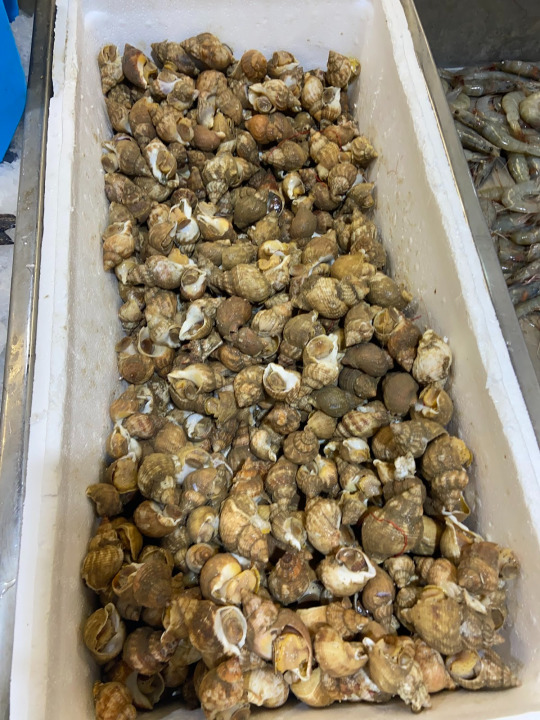
3. Langoustines, Dublin Bay Prawns, or Scampi as they are often called in the UK are small crustaceans in the lobster family. While scampi in North America is typically shrimp in a garlicky white wine-butter sauce served over pasta, scampi in Europe typically refers to the cooked tails of the langoustine in many preparations. Most common on British menus is breaded scampi, usually served with chips and Tartar sauce. Recipe: https://www.bbcgoodfood.com/recipes/scampi-tartare-sauce
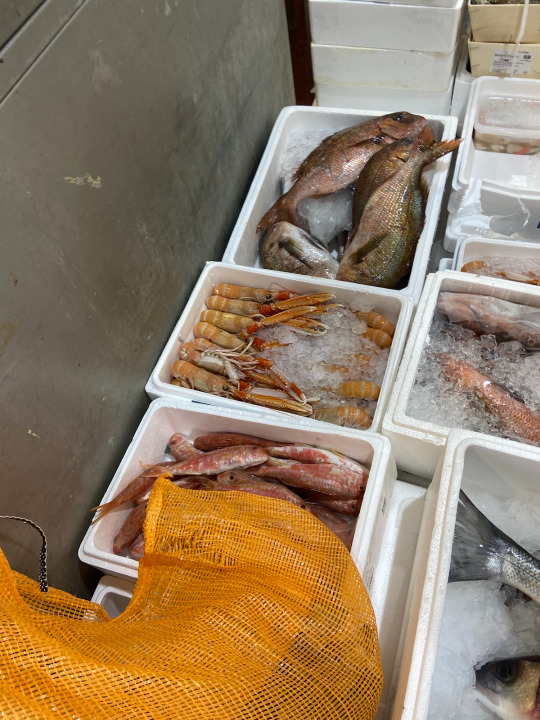
4. Monkfish is a type of anglerfish and has evolved over time from discard to restaurant darling. Its original reputation as a second-rate fish was likely due to its hideous looks, but beneath that frightening exterior hides mild, succulent flesh that has sometimes been called “poor man’s lobster” although the price has risen significantly. In the market it was sold headless, with the skin peeled back to reveal the white flesh of the loins and tail. The boneless fillets are adaptable to a number of cooking styles, but the flavour is delicate and can be masked by strong sauces. The firm texture of the flesh will hold up to methods such as grilling or roasting. In France it is often served in soups, whereas Japanese restaurants, the liver, referred to as ‘ankimo’ is prized, and many are exported from Britain. Recipe: https://www.jamieoliver.com/recipes/fish-recipes/grilled-or-roasted-monkfish-with-black-olive-sauce-and-lemon-mash/

5. Throughout the market we saw displays of cuttlefish cloaked in messy black ink, and one of the highlights of the trip for me was getting to break down a cuttlefish under instruction from CJ Jackson. Cuttlefish is similar to squid in taste and texture, and the ink sacs in its mantle are also highly valued for cooking. Much of the cuttlefish catch is exported to places like Spain and Portugal, but just like squid it is delicious quickly fried, sautéed, or stir fried, or slowly braised. Its neutral flavour makes it adaptable for a variety of cuisines, and both the mantle, cut into strips, and the tentacles can be eaten, though the tentacles are typically slow cooked. One of the most popular preparations for squid and cuttlefish in England is to batter or crumb and fry it, both in the style of the Mediterranean as calamari and Chinese-style salt and pepper squid/cuttlefish. Recipe: https://www.telegraph.co.uk/recipes/0/crispy-fried-salt-and-pepper-cuttlefish-brixham-calamari-recipe/

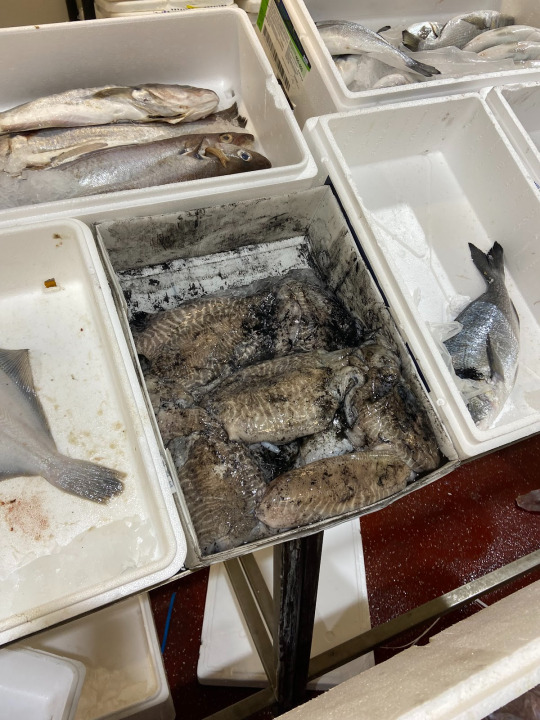
0 notes
Text
One thing I've been thinking about for a while is how race is determined in Arknights. Obviously it's easy to tell lizard person or not, but there are some cases where it's not that clear cut. The specific examples I'm thinking of are the Aslan, the lion people, the Rebbah, also called the Reproba, the hyena people, and the Aegir, the sea people.
As far as the Aslan go, the way they stand out is pretty simple. They have their own distinct race, despite all other peoples based on Felidae being part of the Feline race. The Rebbah, although not as obvious, have the same issue. Hyenas wouldn't stand out, if not for the fact that Folinic, a mongoose person, is also a member of the Feline race. Hyenas and mongooses are fairly closely related to one another, and both are members of the Feliformia suborder of taxonomy. If the rules of categorization were consistent, hyenas would be part of the Feline race, not their own distinct group. The Aegir are an even more extreme example, but in the opposite direction, seemingly consisting of all manner of marine life, ranging from jellyfish to seadragons to cuttlefish to porpoises.
It then occurred to me that race on Terra was likely to be just as much a social and political construct as it is here on Earth. While it's just as unlikely for someone on Terra to mistake an Ursus for a Lung as it would be for someone on Earth to mistake a northern European for an east Asian, race is much more a social construct than people realize. There are numerous times throughout history that race has been changed or constructed entirely for political ends. The examples that occurred to me most immediately was how the multifaceted racial spectrum of Luisiana was simplified to Black and White when it passed from the control of the French to the United States, the numerous laws set in place codifying the definition and privileges of the Manchu during China's Qing dynasty, or, in China again, how the Communist party created the country's 97 official ethnic groups after their initial census after taking power resulted in the population reporting hundreds, if not thousands, of distinct ethnicity.
My supposition is that similar events occurred in Terra's past, resulting in how certain races go against the usual mode of consistency.
The Aslan are the rulers of Victoria, having taken power from the Draco that used to rule it before them. The lion people may have once been considered part of the Feline race, but after coming to power, they likely would have wanted to distinguish themselves from the rest of the population, which appears to be predominantly feline, and so renamed their group to the Aslan.
The glimpses we've seen of Sargon so far suggest that the Rebbah also hold positions of power in the country, at least in parts of it. In the Originium Dust event we meet Drudge and Picale, two Rebbah nobles whose father gained territory for his service in battle, and Spot's profile says he's from a military family, possibly suggesting the Rebbah form a sort of military aristocracy. They may have changed the name of their race after the coming to power in the period of turmoil in the recent past that Rangers reminisces about at the beginning of the OD event, setting themselves above the other races of Sargon. Beanstalk coming from a farming family in Columbia undermines that theory a bit, though. Maybe her family was exiled to the neighboring country and took up agriculture, or something.
The Aegir race was likely constructed to put people down, rather than raise them up. No spoilers for Undertides, I haven't read anything about it. What little we do know about the Aegir region is that it's close to Iberia, the birthplace of many of Aegir Operators. From what we can gather from character profiles and conversations, Aegir are a persecuted underclass in Iberia, treated as second class citizens by the Liberi, who seem to make up the majority of "true" Iberians. The ancestors of the modern Aegir Iberians likely emigrated from the Aegir region to Iberia, where the rest of the population lumped them together under the common moniker "Aegir." This name for a diverse group of people then spread from Iberia to the rest of Terra as the Aegir left the country to escape discrimination.
In all likelihood I'm giving this way to much, but it's been going around in my head for a while and I wanted to put it down somewhere.
51 notes
·
View notes
Photo

The full book title contains 3777 words and reads as follows: 'The historical development of the Heart i.e. from its formation from Annelida: Clam worm, Seamouse, Lugworm, Megascolex, Tubifex, Pheretima, Freshwater leech, marine leech, land leech. Arthropoda: Ladybird, Krill, Rock Barnacle, Root-headed Barnacle, Copepod, Silverfish, Cairns birdwing, Silver - spotted skipper, Scutigera, Cray fish, Large white, Andonis blue, Camberwell beauty, Tiger swallowtail, Regent skipper, Black – veined white, Green – underside blue, Blue Morpho, Apollo, Guava skipper, Cleopatra, Large copper, Millipede, Orb spider, Black widow spider, Giant crab spider, Wolf spider, Bird – eating spider, Tenebrionid beetle, Green Tiger beetle, African goliath beetle, Scolopendra, Diving beetle, African ground beetle, New guinea weevil, Barnacle, Lobster, Shrimp, Woodlice, Mite, Prawn, Housefly, Butterfly, Monarch butterfly, Peacock butterfly, Honey bee, Fairy shrimp, Horsehoe crab, Tick, Bluebootle, Froghopper, Yellow crazy ant, Water flea, Sea spider, Fiddler crab, Shiny spider crab, Hermit crab, Sail swallowtail, Red admiral, Morpho butterfly, Desert locust, Stephens island weta, Speckled bush cricket, Mole cricket, Dung – beetle, Euthalia ynipardus, Small blues, Termite, Hornet, Mosquito, Garden spider, Tarantula, Desert hairy scorpion, Emperor dragon – fly, Moth, Centipede, Wood ant, Stag beetle, Indian red admiral, Blue admiral, Harvestman, Hoverfly, Shield bug, Assassin bug, Cicada, Coreid bug, Rose aphid, Water – boatman, Wasp, June bug, Large tortoiseshell, Frog beetle, Mexican red – legged tarantula, Paintedlady, Sydney funnelweb spider, Small tortoiseshell, Mountain bumble bee, Trapdoor spider, Jumping spider, Daddy longlegs spider, Orchind bee, Asian carpenter bee, Parasitic bee, House spider, Giant longhorn beetle, Flea, Bedbug Beetle, Cockroach, Scorpion, Spider, Ant, Gnats, Grasshopper, Silver fish, Crab, Great green bush cricket, Elephant hawk – moth. Mollusca: Neomenia, Chaetoderma, Chiton, Lepidopleurus, Apple snail, Sea hare, Sea lemon, Dentalium, Freshwater mussel, Marine mussel, Pearl oyster, Cuttlefish, Giant squid, Chambered fish, Devilfish. Fishes or Pisces: African glass catfish, African lungfish, Aholehole, Airbreathing catfish, Alaska blackfish, Albacore, Alewife, Alfonsino, Algae eater, Alligatorfish, Alligator gar, Amberjack - Seriola dumerili, American sole, Amur pike, Anchovy, Anemonefish, Angelfish, Angler, Angler catfish, Anglerfish, Antarctic cod, Antarctic icefish, Antenna codlet, Arapaima, Archerfish, Arctic char, Armored gurnard, Armored searobin, Armorhead, Armorhead catfish, Armoured catfish, Arowana, Arrowtooth eel, Asian carps, Asiatic glassfish, Atka mackerel, Atlantic Bonito (Sarda sarda), Atlantic cod, Atlantic herring, Atlantic salmon, Atlantic Sharpnose Shark - Rhizoprioltodon terraenovae, Atlantic saury, Atlantic silverside, Australasian salmon, Australian grayling, Australian herring, Australian lungfish, Australian prowfish, Ayu, Baikal oilfish, Bala shark, Ballan wrasse, Bamboo shark, Banded killifish, Bandfish, Banjo, Bangus, Banjo catfish, Bank Sea Bass, Barb, Barbel, Barbeled dragonfish, Barbeled houndshark, Barbel-less catfish, Barfish, Barracuda, Barracudina, Barramundi, Barred danio, Barreleye, Basking shark, Bass, Basslet, Batfish, Bat ray, Beachsalmon, Beaked salmon, Beaked sandfish, Beardfish, Beluga sturgeon, Bengal danio, Betta, Bichir, Bicolor goat fish, Bigeye, , Bighead carp, Bigmouth buffalo, Bigscale, Billfish, Bitterling, Black angelfish, Black bass, Black dragonfish, Blackchin, Blackfin Tuna - Thunnus atlanticus, Blackfish, Black neon tetra, Blacktip reef shark, Black mackerel, Black scalyfin, Black sea bass, Black scabbardfish, Black swallower, Black tetra, Black triggerfish, Bank Sea Bass aka Yellow Sea Bass - Centropristis ocyurus, Bleak, Blenny, Blind goby, Blind shark, Blobfish, Blueline Tilefish, Blowfish, Blue catfish, Blue danio, Blue-redstripe danio, Blueline Tilefish , Blue eye, Bluefin tuna, Bluefish, Bluegill, Blue gourami, Blue shark, Blue triggerfish, Blue whiting, Bluntnose knifefish, Bluntnose minnow, Boafish, Boarfish, Bobtail snipe eel, Bocaccio, Boga, Bombay duck, Bonefish, Bonito, Bonnetmouth, Bonytail chub, Bronze corydoras, Bonytongue, Bowfin, Boxfish, Bramble shark, Bream, Brill, Bristlemouth, Bristlenose catfish, Broadband dogfish, Brook lamprey, Brook trout, Brotula, Brown trout, Buffalo fish, Bullhead, Bullhead shark, Bull shark, Bull trout, Burbot, Bumblebee goby, Buri, Burma danio, Burrowing goby, Butterfish, Butterfly ray, Butterflyfish, California flyingfish, California halibut, Canary rockfish, Candiru, Candlefish, Capelin, Cardinalfish, Cardinal tetra, Carp, Carpetshark, Carpsucker, Catalufa, Catfish, Catla, Cat shark, Cavefish, Celebes rainbowfish, Central mudminnow, Chain pickerel, Channel bass, Channel catfish, Char, Cherry salmon, Chimaera, Chinook salmon, Cherubfish, Chub, Chubsucker, Chum salmon, Cichlid, Cisco, Climbing catfish, Climbing gourami, Climbing perch, Clingfish, Clownfish, Clown loach, Clown triggerfish, Cobbler, Cobia, Cod, Codlet, Codling, Coelacanth, Coffinfish, Coho salmon, Coley, Collared carpetshark, Collared dogfish, Colorado squawfish, Combfish, Combtail gourami, Common carp, Common tunny, Conger eel, Convict blenny, Convict cichlid, Cookie-cutter shark, Coolie loach, Cornetfish, Cowfish, Cownose ray, Cow shark, Crappie, Creek chub, Crestfish, Crevice kelpfish, Croaker, Crocodile icefish, Crocodile shark, Crucian carp, Cuckoo wrasse, Cusk, Cusk-eel, Cutlassfish, Cutthroat eel, Cutthroat trout, Dab, Dace, Desert pupfish, Devario, Devil ray, Dhufish, Discus, Diver: New Zealand sand diver or long-finned sand diver, Dogfish, Dogfish shark, Dogteeth tetra, Dojo loach, Dolly Varden trout, Dolphin fish - Corypaena hippurus, Dorab, Dorado, Dory, Dottyback, Dragonet, Dragonfish, Dragon goby, Driftfish, Driftwood catfish, Drum, Duckbill, Duckbill eel, Dusky grouper, Dusky Shark - Carcharhinus obscurus, Dwarf gourami, Dwarf loach, Eagle ray, Earthworm eel, Eel, Eel cod, Eel-goby, Eelpout, Eeltail catfish, Elasmobranch, Electric catfish, Electric eel, Electric knifefish, Electric ray, Elephant fish, Elephantnose fish, Elver, Ember parrotfish, Emerald catfish, Emperor angelfish, Emperor bream, Escolar, Eucla cod, Eulachon, European chub, European eel, European flounder, European minnow, European perch, False brotula, False cat shark, False moray, Fangtooth, Fathead sculpin, Featherback, Fierasfer, Fire goby, Filefish, Finback cat shark, Fingerfish, Firefish, Flabby whale fish, Flagblenny, Flagfin, Flagfish, Flagtail, Flashlight fish, Flatfish, Flathead, Flathead catfish, Flier, Flounder, Flying gurnard, Flying fish, Footballfish, Forehead brooder, Four-eyed fish, French angelfish, Freshwater eel, Freshwater hatchetfish, Freshwater shark, Frigate mackerel, Frilled shark, Frogfish, Frogmouth catfish, Fusilier fish, Galjoen fis, Ganges shark, Geel, Garibaldi, Garpike, Ghost fish, Ghost flathead, Ghost knifefish, Ghost pipefish, Ghost shark, Ghoul, Giant danio, Giant gourami, Giant sea bass, Gibberfish, Gila trout, Gizzard shad, Glass catfish, Glassfish, Glass knifefish, Glowlight danio, Goatfish, Goblin shark, Goby, Golden dojo, Golden loach, Golden shiner, Golden trout, Goldeye, Goldfish, Gombessa, Goosefish, Gopher rockfish, Gourami, Grass carp, Graveldiver, Grayling, Gray mullet, Gray reef shark, Great white shark, Green swordtail, Greeneye, Greenling, Grenadier, Green spotted puffer, Ground shark, Grouper, Grunion, Grunt, Grunter, Grunt sculpin, Gudgeon, Guitarfish, Gulf menhaden, Gulper eel, Gulper, Gunnel, Guppy, Gurnard, Haddock, Hagfish, Hairtail, Hake, Halfbeak, Halfmoon, Halibut, Halosaur, Hamlet, Hammerhead shark, Hammerjaw, Handfish, Hardhead catfish, Harelip sucker, Hatchetfish, Hawkfish, Herring, Herring smelt, Hickory Shad, Horn shark, Horsefish, Houndshark, Huchen, Humuhumunukunukuapua'a, Hussar, Icefish, Ide, Ilisha, Inanga, Inconnu, Jack, Jackfish, Jack Dempsey, Japanese eel, Javelin, Jawfish, Jellynose fish, Jewelfish, Jewel tetra, Jewfish, John Dory, Kafue pike, Kahawai, Kaluga, Kanyu, Kelp perch, Kelpfish, Killifish, King of the herrings, Kingfish, King-of-the-salmon, Kissing gourami, Knifefish, Knifejaw, Koi, Kokanee, Kokopu, Kuhli loach, Labyrinth fish, Ladyfish, Lake chub, Lake trout, Lake whitefish, Lampfish, Lamprey, Lanternfish, Largemouth bass, Leaffish, Lefteye flounder, Lemon shark, Lemon sole, Lemon tetra, Lenok, Leopard danio, Lightfish, Limia, Lined sole, Ling, Ling cod, Lionfish, Livebearer, Lizardfish, Loach, Loach catfish, Loach goby, Loach minnow, Longfin, Longfin dragonfish, Longfin escolar, Longfin smelt, Long-finned char, Long-finned pike, Longjaw mudsucker, Longneck eel, Longnose chimaera, Longnose dace, Longnose lancetfish, Longnose sucker, Longnose whiptail catfish, Long-whiskered catfish, Loosejaw, Lost River sucker, Louvar, Loweye catfish, Luderick, Luminous hake, Lumpsucker, Lungfish, Mackerel, Mackerel shark, Madtom, Mahi-mahi, Mahseer, Mail-cheeked fish, Mako shark, Mandarinfish, Masu salmon, Medaka, Medusafish, Megamouth shark, Menhaden, Merluccid hake, Mexican golden trout, Midshipman fish, Milkfish,, Minnow, Minnow of the deep, Modoc sucker, Mojarra, Mola, Monkeyface prickleback, Monkfish, Mooneye, Moonfish, Moorish idol, Mora, Moray eel, Morid cod, Morwong, Moses sole, Mosquitofish, Mouthbrooder, Mozambique tilapia, Mrigal, Mud catfish (Mud cat), Mudfish, Mudminnow, Mud minnow, Mudskipper, Mudsucker, Mullet, Mummichog, Murray cod, Muskellunge, Mustache triggerfish, Mustard eel, Naked-back knifefish, Nase, Needlefish, Neon tetra, New World rivuline, New Zealand smelt, Nibble fish, Noodlefish, North American darter, North American freshwater catfish, North Pacific daggertooth, Northern anchovy, Northern clingfish, Northern lampfish, Northern pike, Northern sea robin, Northern squawfish, Northern stargazer, Notothen, Nurseryfish, Nurse shark, Oarfish, Ocean perch, Ocean sunfish, Oceanic whitetip shark, Oilfish, Oldwife, Old World knifefish, Olive flounder, Opah, Opaleye, Orange roughy, Orangespine unicorn fish, Orangestriped triggerfish, Orbicular batfish, Orbicular velvetfish, Oregon chub, Orfe, Oriental loach, Oscar, Owens pupfish, Pacific albacore, Pacific cod, Pacific hake, Pacific herring, Pacific lamprey, Pacific salmo, Pacific saury, Pacific trout, Pacific viperfish, Paddlefish, Pancake batfish, Panga, Paradise fish, Parasitic catfish, Parore, Parrotfish, Peacock flounder, Peamouth, Pearleye, Pearlfish, Pearl danio, Pearl perch, Pelagic cod, Pelican eel, Pelican gulper, Pencil catfish, Pencilfish, Pencilsmelt, Peppered corydoras, Perch, Peters' elephantnose fish, Pickerel, Pigfish, Pike conger, Pike eel, Pike, Pikeblenny, Pikeperch, Pilchard, Pilot fish, Pineapplefish, Pineconefish, Pink salmon, Píntano, Pipefish, Piranha, Pirarucu, Pirate perch, Plaice, Platy, Platyfish, Pleco, Plownose chimaera, Poacher, Pollock, Pomfret, Pompano dolphinfish, Ponyfish, Popeye catalufa, Porbeagle shark, Porcupinefish, Porgy, Port Jackson shark, Powen, Prickleback, Pricklefish, Prickly shark, Prowfish, Pufferfish, Pumpkinseed, Pupfish, Pygmy sunfish, Queen danio, Queen parrotfish, Queen triggerfish, Quillback, Quillfish, Rabbitfish, Raccoon butterfly fish, Ragfish, Rainbow trout, Rainbowfish, Rasbora, Ratfish, Rattail, Ray, Razorback sucker, Razorfish, Red Grouper, Red salmon, Red snapper, Redfin perch, Redfish, Redhorse sucker, Redlip blenny, Redmouth whalefish, Redtooth triggerfish, Red velvetfish, Red whalefish, Reedfish, Reef triggerfish, Remora, Requiem shark, Ribbon eel, Ribbon sawtail fish, Ribbonfish, Rice eel, Ricefish, Ridgehead, Riffle dace, Righteye flounder, Rio Grande perch, River loach, River shark, River stingray, Rivuline, Roach, Roanoke bass, Rock bass, Rock beauty, Rock cod, Rocket danio, Rockfish, Rockling, Rockweed gunnel, Rohu, Ronquil, Roosterfish, Ropefish, Rough scad, Rough sculpin, Roughy, Roundhead, Round herring, Round stingray, Round whitefish, Rudd, Rudderfish, Ruffe, Russian sturgeon, Sábalo, Sabertooth, Saber-toothed blenny, Sabertooth fish, Sablefish, Sacramento blackfish, Sacramento splittail, Sailfin silverside, Sailfish, Salamanderfish, Salmon, Salmon shark, Sandbar shark, Sandburrower, Sand dab, Sand diver, Sand eel, Sandfish, Sand goby, Sand knifefish, Sand lance, Sandperch, Sandroller, Sand stargazer, Sand tiger, Sand tilefish, Sandbar Shark - Carchathinus plumbeus, Sarcastic fringehead, Sardine, Sargassum fish, Sauger, Saury, Sawfishm, Saw shark, Sawtooth eel, Scabbard fish, Scaly dragonfish, Scat, Scissortail rasbora, Scorpionfish, Sculpin, Scup, Sea bass, Sea bream, Sea catfish, Sea chub, Sea devil, Sea dragon, Sea lamprey, Sea raven, Sea snail, Sea toad, Seahorse, Seamoth, Searobin, Sevan trout, Sergeant major, Shad, Shark, Sharksucker, Sharpnose puffer, Sheatfish, Sheepshead, Sheepshead minnow, Shiner, Shortnose chimaera, Shortnose sucker, Shovelnose sturgeon, Shrimpfish, Siamese fighting fish, Sillago, Silver carp, Silver dollar, Silver dory, Silver hake, Silverside, Silvertip tetra, Sind danio, Sixgill ray, Sixgill shark, Skate, Skilfish, Skipjack tuna, Slender mola, Slender snipe eel, Sleeper, Sleeper shark, Slickhead, Slimehead, Slimy mackerel, Slimy sculpin, Slipmouth, Smalleye squaretail, Smalltooth sawfish, Smelt, Smelt-whiting, Smooth dogfish, Snailfish, Snake eel, Snakehead, Snake mackerel, Snapper, Snipe eel, Snipefish, Snoek, Snook, Snubnose eel, Snubnose parasitic eel, Sockeye salmon, Soldierfish, Sole, South American darter, South American lungfish, Southern Dolly Varden, Southern flounder, Southern hake, Southern sandfish, Southern smelt, Spadefish, Spaghetti eel, Spanish mackerel, Spearfish, Speckled trout, Spiderfish, Spikefish, Spinefoot, Spiny basslet, Spiny dogfish, Spiny dwarf catfish, Spiny eel, Spinyfin, Splitfin, Spookfish, Spotted climbing perch, Spotted danio, Spottail Pinfish - Diplodus holbrooki, Sprat, Springfish, Squarehead catfish, Squaretail, Squawfish, Squeaker, Squirrelfish, Staghorn sculpin, Stargazer, Starry flounder, Steelhead, Stickleback, Stingfish, Stingray, Stonecat, Stonefish, Stoneroller minnow, Stream catfish, Striped bass, Striped burrfish, Sturgeon, Sucker, Suckermouth armored catfish, Summer flounder, Sundaland noodlefish,Sunfish, Surf sardine, Surfperch, Surgeonfish, Swallower, Swamp-eel, Swampfish, Sweeper, Swordfish, Swordtail, Tadpole cod, Tadpole fish, Tailor, Taimen, Tang, Tapetail, Tarpon, Tarwhine, Telescopefish, Temperate bass, Temperate perch, Tenpounder, Tenuis, Tetra, Thorny catfish, Thornfish, Threadfin, Threadfin bream, Thread-tail, Three spot gourami, Threespine stickleback, Three-toothed puffer, Thresher shark, Tidewater goby, Tiger barb, Tigerperch, Tiger shark, Tiger shovelnose catfish, Tilapia, Tilefish, Titan triggerfish, Toadfish, Tommy ruff, Tompot blenny, Tonguefish, Tope, Topminnow, Torpedo, Torrent catfish, Torrent fish, Trahira, Treefish, Trevally, Triggerfish, Triplefin blenny, Triplespine, Tripletail, Tripod fish, Trout, Trout cod, Trout-perch, Trumpeter, Trumpetfish, Trunkfish, Tubeblenny, Tube-eye, Tube-snout, Tubeshoulder, Tui chub, Tuna, Turbot, Two spotted goby, Uaru, Unicorn fish, Upside-down catfish, Vanjaram, Velvet belly lanternshark, Velvet catfish, Velvetfish, Vermillion Snapper - Rhomboplites aurorubens, Vimba, Viperfish, Wahoo, Walking catfish, Wallago, Walleye, Walleye Pollock, Walu, Warmouth, Warty angler, Waryfish, Waspfish, Weasel shark, Weatherfish, Weever, Weeverfish, Wels catfish, Whale catfish, Whalefish, Whale shark, Whiff, Whitebait, White croaker, Whitefish, White marlin, White shark, Whitetip reef shark, Whiting, Wobbegong, Wolf-eel, Wolffish, Wolf-herring, Worm eel, Wormfish, Wrasse, Wrymouth, X-ray fish, Yellowback fusilier, Yellowbanded perch, Yellow bass, Yellowedge grouper (Hyporthodus flavolimbatus), Yellow-edged moray, Yellow-eye mullet, Yellowhead jawfish, Yellowfin croaker, Yellowfin cutthroat trout, Yellowfin grouper, Yellowfin Tuna - Thunnus albacares, Yellowfin pike, Yellowfin surgeonfish, Yellowfin tuna, Yellowmargin triggerfish, Yellow moray, Yellow perch, Yellowtail, Yellowtail amberjack, Yellowtail barracuda, Yellowtail clownfish, Yellowtail horse mackerel, Yellowtail kingfish, Yellowtail snapper, Yellow tang, Yellow weaver, Yellowtail catfish, Zander, Zebra bullhead shark, Zebra danio, Zebrafish, Zebra lionfish, Zebra loach, Zebra oto, Zebra pleco, Zebra shark, Zebra tilapia, Zebra turkeyfish, Ziege, Zingel. Amphibians: Frogs and Toads, Painted frogs, Disc tongued frogs, Fire Belly toads, Litter frogs, European Spadefoot toads, Parsley frogs, Tongueless frogs, Clawed frogs, Mexican Burrowing Toad, American spadefoot toads, Screeching frogs, True toads, Glass Frogs, Poison dart frogs, Ghost frogs, Shovelnose frogs, Tree frogs, Sedge frogs, Southern frogs, Narrow-mouthed frogs, Australian ground frogs, True frogs, Moss frogs, Seychelles frog, Giant Salamanders, Asiatic Salamanders, Mole Salamanders, Pacific giant salamanders, Amphiumas, Lungless salamanders, Mudpuppies and Waterdogs, Torrent salamanders, True salamanders and Newts, Sirens, Common caecilians, Fish caecilians, Beaked caecilians. Reptiles: Turtles, common snapping turtles and alligator snapping turtle, pond turtles and box turtles, tortoises, Asian river turtles and allies, pignose turtles, softshell turtles, river turtles, mud turtles, sea turtles, leatherback turtles, tuataras, scaled reptiles, agamas, chameleons, casquehead lizard, iguanas, Madagascar iguanids, collared and leopard lizards, horned lizards, anoles, wood lizards, Neotropical ground lizards, geckos, legless lizards, blind lizards, spinytail Lizards, plated lizards, spectacled lizards, whiptails and tegus, Lacertids, skinks, night lizards, glass lizards, American legless lizards, knob-scaled lizards, gila monsters, earless Monitor lizards, monitor lizards, worm Lizards, shorthead Worm Lizards, two-legged Worm Lizards, snakes, wart snakes, false coral snakes, dwarf pipe snakes, African burrowing asps, stiletto snakes, boas, anacondas, Old World sand boas, Mauritius snakes, Colubrids, typical snakes, Asian pipe snakes, cobras, coral snakes, mambas, sea snakes, Mexican pythons, pythons, dwarf boas, pipe snakes, shield-tailed snakes, vipers, pitvipers, Fae's viper, night adders, pitvipers, rattlesnakes, true vipers, sunbeam snakes, blind snakes, primitive blind snakes, slender blind snakes, thread snakes, blind snakes, typical blind snakes, Crocodiles, alligators, garials. Aves: Ostrich, rheas, cassowaries and emu, kiwis, elephant birds, upland moas, great moas, lesser moas, Tinamous, Australian brush turkey,megapodes, chachalacas, curassows, and guans, Guineafowl, pheasants and allies, New World quail, pheasants and relatives, mihirungs, screamers, magpie-goose, ducks, geese, and swans, grebes, swimming flamingos, flamingos, pigeons and doves, sandgrouse, mesites, Tawny frogmouth, Nightjars, oilbird, potoos, frogmouths, owlet-nightjars, treeswifts, swifts, hummingbird, cuckoos and relatives, turacos and relatives, bustards, hoatzin, cranes and allies, cranes, limpkin, trumpeters, rails and allies, adzebills, finfoots, flufftails, rails and relatives, thick-knees and allies, thick-knees and relatives, sheathbills, Magellanic plover, plover-like waders, golden plovers, ibisbill, oystercatchers, plovers and lapwings, jacana-like waders, painted snipes, Egyptian plover, jacanas, seedsnipes, plains-wanderer, sandpipers and relatives, buttonquail, gulls and allies, coursers and pratincoles, crab-plover, skuas and jaegers, auks and puffins, gulls, skimmers and terns, sunbittern, tropicbirds, penguins, albatrosses, austral storm petrels, northern storm petrels, petrels and relatives, White stork, storks, frigatebirds, boobies and gannets, darters, cormorants and shags, ibises and spoonbills, hamerkop, shoebill, pelicans, herons and relatives, New World vultures, secretarybird, osprey, hawks, eagles, buzzards, harriers, kites and Old World vultures, barn owls, true owls, mousebirds, cuckooroller, trogons and quetzals, hornbills, hoopoe, woodhoopoes, bee-eater, rollers, ground rollers, todies, motmots, Kingfisher, jacamars, puffbirds, African barbets, Asian barbets, toucans, toucan barbets, American barbets, woodpeckers, honeyguides, seriemas, falcons and relatives, kakapo, kea and kakas, cockatoos, African and American parrots, Australasian parrots, Pesquet's parrot, vasa parrots, Pitta cyanea, Lyrebird, New Zealand wrens, suboscines, Old World suboscines, sapayoa, Calyptomenid broadbills, pittas, broadbills, asities, New World suboscines, bronchophones, manakins, cotingas, sharpbills, royal flycatchers and allies, becards and tityras, spadebills, many-colored rush tyrants, mionectine flycatchers, tyrant flycatchers, tracheophones, crescent-chests, gnateaters, antbirds, antpittas, ground antbirds, ovenbirds, oscines, scrub-birds, lyrebirds, bowerbirds, Australasian treecreepers, Australasian wrens, bristlebirds, gerygones and allies, honeyeaters and relatives, Australasian babblers, logrunners, quail-thrushes and jewel-babblers, cuckoo-shrikes, whitehead and allies, sittellas, wattled ploughbills, whipbirds and quail-thrushes, Australo-Papuan bellbirds, crested shriketits, painted berrypeckers, vireos and relatives, whistlers and relatives, Old World orioles, Boatbills, woodswallows and butcherbirds, mottled berryhunter, ioras, bristlehead, bushshrikes and relatives, wattle-eyes and batises, vangas , fantails, silktail, drongo fantail, drongos, blue-capped ifrits, Australian mudnesters, birds-of-paradise, monarch flycatchers, shrikes, jays and crows, berrypeckers, satinbirds, Australasian robins, stitchbird, wattlebirds, rockfowl, rock-jumpers, rail-babbler, fairy warblers, hyliotas, penduline tits, chickadees and true tits, Nicators, bearded reedling, larks, African warblers, cisticolas and relatives, marsh warblers, pygmy wren-babblers, grass warblers, Malagasy warblers, swallows and martins, bulbuls, leaf warblers, bush warblers , Bushtits, true warblers, parrotbills, fulvettas, white-eyes, babblers and relatives, fulvettas, ground babblers, laughing thrushes, kinglets, spotted wren-babblers, Hawaiian honeyeaters, silky-flycatchers, waxwings, Palmchat, hypocolius, wallcreeper, nuthatches, treecreepers, wrens, gnatcatchers, dippers, thrushes and relatives, flycatchers and relatives, oxpeckers, mockingbirds and thrashers, starlings and mynas , sugarbirds, dapplethroat and allies, flowerpeckers, sunbirds, fairy-bluebirds, leafbirds, olive warbler, accentors, pink-tailed bunting, weavers and relatives, whydahs and indigobirds, weaver finches, Old World sparrows, wagtails and pipits, finches and relatives, longspurs, snow buntings, rosy thrush-tanagers, Old World buntings and New World sparrows, American sparrows, palm-tanager and allies, New World blackbirds and New World orioles, Cuban warblers, wood warblers, cardinals, grosbeaks, and New World buntings, tanagers and relatives. MAMMALS: Rat, Bat, Horse, Standardbred, Throughbred, Saddlebred, Arab, Palomino, Australian stock, Appaloosa, Barb, Lippizaner, Mustang, American Shetland, Falabella, Percheron, Shire, Mule, Bullock, Setter, Oxen, Camel, Tiger, Lion, Hyaenas, Leopard, Bear, Cat, Dog, Sheep, Goat, Cow, Cob, Pig, Chamois, Bulldog, Borzoi, Loris, Longspur, Harvest mouse, Spiny – ant eater, Duck – billed platypus, Elephant, Rhinoceros, Tonkinese, Ragdoll, Margay, Tapir, Seal, Sea lion, Walrus, Dolphin, Bactrian camel, Arabian camel, Bushbaby, Burmese cat, Whale, Porpoise, Aardvark, Ape, Monkey, Gorilla, Chimpanzee, Flying Lemur, Hare, Pika, Macaque, Rabbit, Colobus, Antelope, Caribou, Cattle, Deer, Grizzly bear, Hyrax, Armadillo, Porcupine, Hedgehog, Arctic hare, Mole, Shrew, Beaver, Asian black bear, Polar bear, Sloth bear, Spectacled bear, Mouse, Squirrel, Dugong, Moose, Fallow deer, Reindeer, Red deer, Manatee, Egyptian Mau, Scottish fold, Himalayan, Birman, Red squirrel, Hippopotamus, Weasel, Whale, Wither, Blue whale, Sperm whale, Killer whale, Wallaby, Beluga, Baird’s beaked whale, Grey whale, Bryde’s whale, Pygmy right whale, Southern right whale, Seal, Ape, Indri, Aye – aye, Alaskan Malamute, Dobermann, Beagle, Kinkajou, Afgan Hound, Rough Collie, Cardigan Welsh Corgi, Sheepdog, Pointer, Poddle, Weimaraner, Bloodhound, Zebra, Giraffe, Yak, Arctic fox, Polecat, Golden Retriever, Kerry Blue, Prairie dog, Airedale, German spitz, Pekingese, Otter, Shih Tzu, Proboscis monkey, Orang – utan, Red Howler monkey, Spider monkey, Sloth, Koala, Pangolin, Mustelid, Mongoose, Guinea pig, Malayan Porcupine, Naked Mole rat, Capybara, Pallid Gerbil, Brown rat, Somali, Ocicat, Balinese, Bengal, Cymric, Chartreux, Devon Rex, Turkish Angora, Russian Blue, Yellow – necked woodmouse, Hamster, Grey squirrel, Chipmunk, Fox, Blue Longhair, Chinese Pangolin, Blue – cream shorthair, Tortoiseshell and white shorthair, Brown spotted shorthair, Red and white Japanese bobtail, Javanese, Red Persian Longhair, Brown classic tabby maine coon, Lilac angora, Seal point Siamese, Brown and white sphinx, Red classic tabby manx, Vampire bat, Proboscis bat, Franquet’s fruit bat, Bengal Tiger, Horseshoe bat, Noctule bat, Funnel - eared bat, Blue exotic, Foreign lilac oriental shorthair, Boxer, Bay, Cream point colour pointed british shorthair, Abyssinian, Cinnamon silver Cornish rex, Wolverine, Skunk, Human being, Pine marten, Stoat, Chocolate point longhair, Husky, Ant eater, Kangaroo, Gray Mouse Lemur, Musk oxen, Raccoon dogrie, Pasnda, Bouto, Pembroke Welsh corgi, Whippet, Whisker, Indus river dolphin, Franciscana, Sorrel, Finless porpoise, Jerboa, Harbour porpoise, Bottlenose dolphin, Border Collie, Diana Monkey, White – beaked dolphin, Atlantic white – sided dolphin, Bobcat, Alpaca, Aberdeen angus, Lynx, Pacific white – sided dolphin, Rhesus monkey, Irish wolfhound, Baboon, Slivery marmoset, Puma, Ocelot, Norwegian Forest Cat, Basenji, Keeshond, Akita, Samoyed, Briard, Brittaney, Vizsla, Weimaraner, Saluki, Greyhound, Rottweiler, Bullmastiff, Newfoundland, Puli, Bombay, Sphynx, Kangaroo rat, Humpback whale, Red panda, Maltese, Pug, Chihuahua, Papillon, Pomeranian, Schipperke, Aardwolve, Cheetah, Civet, Red – Bellied Lemur, Moustache, Monkey, Yorkshire terrier, German shepherd, Clumber spaniel, Bouvier des Flandres, Belgian sheepdog, Boston terrier, Italian greyhound, Chesapeake Bay retriever, Genet, Musk deer, Bichon fries, Rock Hyrax, Pony, Mink, Mammoth, Mastodon, Giant sloth, Llama, African Elephant, DeBrazza’s Monkey, Siberian Tiger, Hackney Pony, Bonnet Monkey, German wirehaired pointer, Ferret, Jaguar, Dalmatian, Red Bengal Tiger, Badger, Shunk, Skye terrier, Great dane, Grampus, Bandicoot, Wolf, Marmot, Squirrel monkey, Sable, Minke whale, Spectacle porpoise, Opossums, Airedale, Wombat. etc , Ramapithecus, Australopithecus bosei or Paranthropus bosei, Zinjanthopus bosei, Homo – erectus ( Java man, Peking man, Heidelberg man ), Homo – Sapiens ( Neanderthal man, Cro – Magnon man) to the modern humans with their development and structure of their Heart, their contributions to the formation of the modern humans. What is the origin of the heart? In which place the heart is situated? What is the weight of our (modern humans) heart? Can a person live without a heart? What is the function of the heart? How heart pumps blood to the body? What type of circulation takes place in the human heart? How big our human heart is? Why is our (modern humans) heart considered as the most developed in the world? Why does heart stop? What are heart sounds? What are the types of heart sounds? What causes the heart sounds heard with a stethoscope? What is the anatomy of the heart? Why heart is considered an important organ in the body? Why can’t people live if heartbeat stops? Where is heart located in? How many chambers are present in the heart? What is the number of heart beats per minute? What is the amount of blood pumped by heart? How much blood does the human heart pump in a lifetime? And Short notes on heart attack i.e. what is the definition of a heart attack? Why does a heart attack occur? What are the types of the heart attack? What happens if human get a heart attack? What are the symptoms of Heart attack? What are the causes of the Heart attack? What are the risk factors related to the Heart attack? What are the types of risk factors cause the Heart attack? What are the complications of a Heart attack? What types of diagnosis useful in detecting and treating a heart attack? What treatment is needed to treat heart attack patients? What are 5 strategies to be maintained after the heart attack? What to do after recovery from a heart attack? What is cardiac rehabilitation? Why cardiac rehabilitation is needed to heart attack patients? Does cardiac rehabilitation create positive effects? What are a lifestyle and home remedies are to be maintained? What type of coping and support should be given to heart attack patients? What are the immediate measures should be taken when you encounter an emergency of heart attack patient? What signs and symptoms list should be made to consult a doctor? What is a widow maker heart attack? What is the definition of a widowmaker heart attack? What are the symptoms of Widowmaker heart attack? What are the causes of Widowmaker heart attack? What are the risk factors related to Widowmaker heart attack? What are the complications of a widowmaker heart attack? What types of diagnosis useful in detecting and treating a widowmaker heart attack? What treatment is needed to treat heart attack patients? How to make over your lifestyle? What type of measures should be taken to stay away from a heart attack? What are 20 types of foods should be taken to keep your heart healthy? Solutions and answers of above questions, material and topics are included and cleared in this book.'
26 notes
·
View notes
Photo
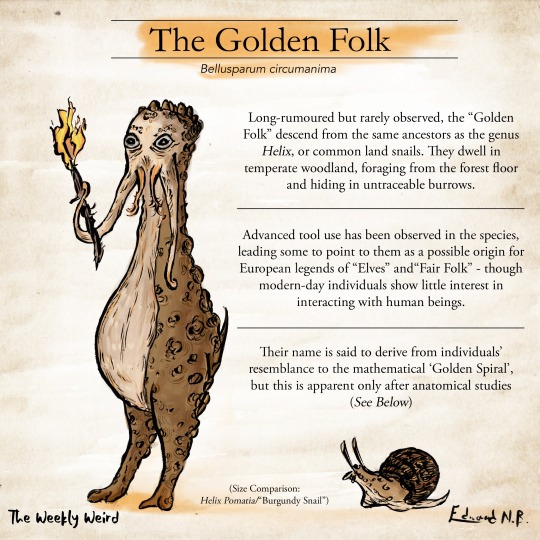
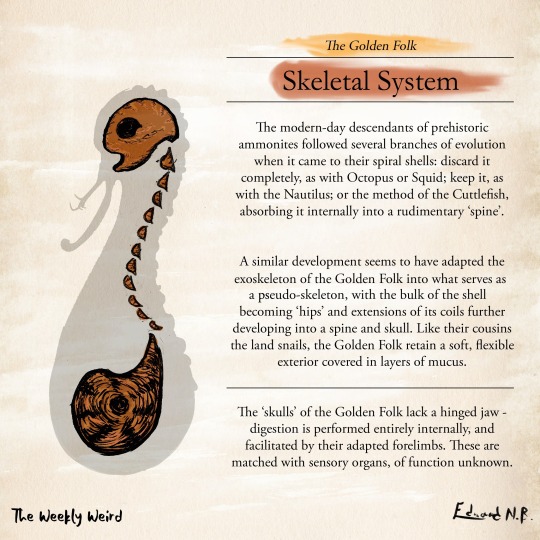
“The Weekly Weird” No. 1 - ‘The Golden Folk’.
An attempt at asking how snails would evolved into sapient life-forms. (ID under the cut)
[ID: two journal pages illustrating and describing a fictional species known as “The Golden Folk”, which appears to be a sapient life-form evolved from modern-day snails. In the first image, The creature stands round-bellied with two short legs, tan and mottled brown skin, and a mouthless head with squinty eyes and long appendages sprouting from its mouth-area which resemble tentacles. In one of these appendages it holds a lit torch.
In the second image, the creature’s rusty brown skeletal system is partly shown, with a jawless skull, spinal column and a spiral hip resembling the shell of a snail.
Text of the images is as follows: “THE GOLDEN FOLK, Bellusparium Rotundanima”: Long-rumoured but rarely observed, the “Golden Folk” descend from the same ancestors as the genus Helix, or common land snails. They dwell in temperate woodland, foraging from the forest floor and hiding in untraceable burrows.
Advanced tool use has been observed in the species, leading some to point to them as a possible origin for European legends of “Elves” and“Fair Folk” - though modern-day individuals show little interest in interacting with human beings.
Their name is said to derive from individuals’ resemblance to the mathematical ‘Golden Spiral’, but this is apparent only after anatomical studies (See Below)
SKELETAL SYSTEM: The modern-day descendants of prehistoric ammonites followed several branches of evolution when it came to their spiral shells: discard it completely, as with Octopus or Squid; keep it, as with the Nautilus; or the method of the Cuttlefish, absorbing it internally into a rudimentary ‘spine’.
A similar development seems to have adapted the exoskeleton of the Golden Folks’ ancestors into a pseudo-skeleton, with the bulk of the shell becoming ‘hips’ and extensions of its coils further developing into a spine and skull. Like their cousins the land snails, the Golden Folk retain a soft, flexible exterior covered in layers of mucus.
The ‘skulls’ of the Golden Folk lack a hinged jaw - digestion is performed entirely internally, and facilitated by their adapted forelimbs. These are matched with sensory organs, of function unknown.]
#edward n. b.#edward nb#speculative zoology#speculative evolution#speculative biology#sci fi#creature design#The Weekly Weird
93 notes
·
View notes
Note
Aww thank you!!! The top one is a red octopus (drawn in black and white lol), the second is the common cuttlefish, and in the third photo, from left to right, it’s a vampire squid, a Bigfin squid, and a European squid!
thank you i love them
1 note
·
View note
Text
Cuttlefish Passed a Cognitive Test Originally Designed for Human Children | My Modern Met
Cuttlefish Passed a Cognitive Test Originally Designed for Human Children | My Modern Met
By Madeleine Muzdakis on March 5, 2021
In this case, the marshmallow was shrimp.
The common (European) cuttlefish (Sepia officinalis).
If you sat in front of a delicious marshmallow, would you be able to wait to eat it? What about if you knew that if you wait, in 15 minutes you could get two? This is the format of the famous Stanford marshmallow experiment, which was designed in the 1970s to…
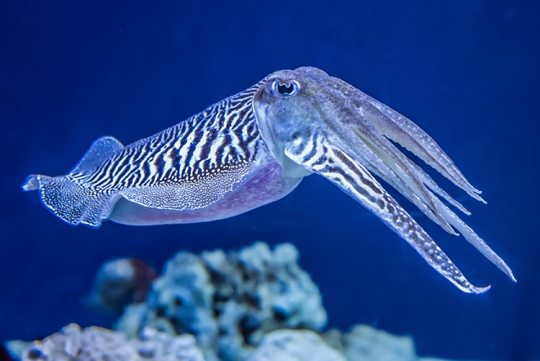
View On WordPress
0 notes
Photo
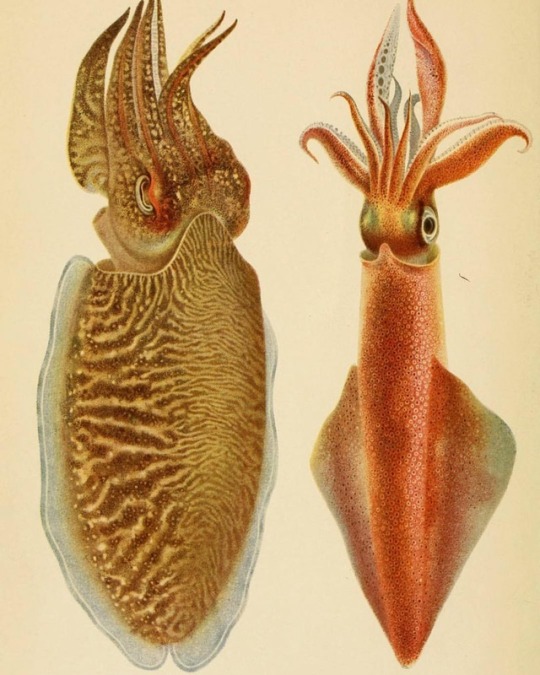
Common cuttlefish (Sepia officinalis) and European squid (Loligo vulgaris) for #CephalopodAwarenessDays! #Cuttlefish have excellent camouflage. They can change their coloring rapidly to match their environment. European #Squid live from sea level to depths of 500 m. They migrate to inshore waters to spawn, where females can lay up to 20,000 eggs. #SciArt from Tintenfische; mit besonderer Berücksichtigung von Sepia und Octopus (1913) by Werner Meyer. Contributed for digitization by Smithsonian Libraries (@silibraries) to #BiodiversityHeritageLibrary. https://www.biodiversitylibrary.org/page/12668599 _________________________________________________ #Cephalopods #MarineLife #Oceans #Seas #BHLib #Biodiversity #NaturalHistory #NatHist #ScientificIllustration #ScientificArt #OpenAccess #Libraries #Archives #SpecialCollections #LibrariesofInstagram #IGLibraries #IG_Libraries #SmithsonianLibraries
#cephalopodawarenessdays#nathist#bhlib#scientificart#biodiversityheritagelibrary#naturalhistory#cuttlefish#libraries#marinelife#openaccess#archives#squid#oceans#scientificillustration#sciart#specialcollections#cephalopods#smithsonianlibraries#librariesofinstagram#biodiversity#iglibraries#seas#ig_libraries
76 notes
·
View notes
Text
Cuttlefish eat less for lunch when they know there'll be shrimp for dinner
https://sciencespies.com/biology/cuttlefish-eat-less-for-lunch-when-they-know-therell-be-shrimp-for-dinner/
Cuttlefish eat less for lunch when they know there'll be shrimp for dinner
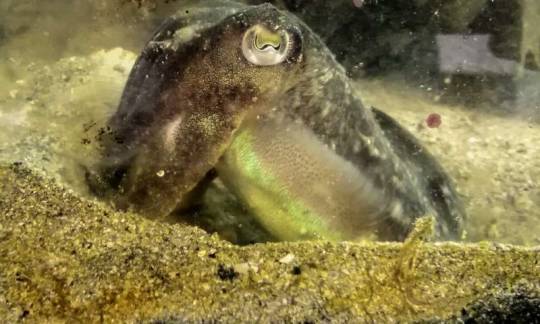

A European common cuttlefish, Sepia officinalis. Credit: Pauline Billard
When cuttlefish know that shrimp—their favourite food—will be available in the evening, they eat fewer crabs during the day. This capacity to make decisions based on future expectations reveals complex cognitive abilities.
“It was surprising to see how quickly the cuttlefish adapted their eating behaviour—in only a few days they learned whether there was likely to be shrimp in the evening or not. This is a very complex behaviour and is only possible because they have a sophisticated brain,” said Pauline Billard, a Ph.D. student in the University of Cambridge’s Department of Psychology and Unicaen, France, and first author of the report.
Cuttlefish foraging behaviour can be described as either selective or opportunistic. Observing the European common cuttlefish, Sepia officinalis, when the researchers reliably provided one shrimp every evening, the cuttlefish became more selective during the day and ate significantly fewer crabs. But when they were provided with evening shrimp on a random basis, the cuttlefish became opportunistic and ate more crabs during the day.
Random provision of evening shrimp meant that the cuttlefish could not predict whether their favourite food would be available for dinner each day, so they made sure they had enough to eat earlier in the day. When conditions changed, the cuttlefish changed their foraging strategy to match.
The researchers saw the animals quickly shift from one eating strategy to another based on their experience. By learning and remembering patterns of food availability, the cuttlefish optimise their foraging activity not only to guarantee they eat enough—but also to make sure they eat more of the foods they prefer.
Cuttlefish eat a wide range of food including crabs, fish and squid, depending on what is available. Despite such a generalised diet, they show strong food preferences. To test this, the researchers tested twenty-nine cuttlefish five times a day, for five days, by putting crab and shrimp at an equal distance from the cuttlefish at the same time and watching what they ate first. All showed a preference for shrimp.
Animals must constantly adapt to changes in their environment in order to survive. Cuttlefish hatch with a large central nervous system, which enables them to learn from a young age. They are capable of remembering things that happened in the past, and using this information to adjust their behaviour in anticipation of the future.
Cuttlefish are a type of cephalopod. In evolutionary terms, cephalopods and vertebrates diverged around 550 million years ago, yet they are remarkably similar in the organisation of their nervous systems.
“This flexible foraging strategy shows that cuttlefish can adapt quickly to changes in their environment using previous experience,” said Professor Nicola Clayton in the University of Cambridge’s Department of Psychology, who led the study. “This discovery could provide a valuable insight into the evolutionary origins of such complex cognitive ability.”
Explore further
3-D movies reveal how cuttlefish determine distance when striking at prey
More information:
Cuttlefish show flexible and future-dependent foraging cognition, Biology Letters, royalsocietypublishing.org/doi … .1098/rsbl.2019.0743
Provided by
University of Cambridge
Citation:
Cuttlefish eat less for lunch when they know there’ll be shrimp for dinner (2020, February 4)
retrieved 4 February 2020
from https://phys.org/news/2020-02-cuttlefish-lunch-therell-shrimp-dinner.html
This document is subject to copyright. Apart from any fair dealing for the purpose of private study or research, no
part may be reproduced without the written permission. The content is provided for information purposes only.
#Biology
0 notes
Text
The cuttlefish may be flashy, but its microbiome is super simple
Scientist have characterized the microbiome of the European common cuttlefish, Sepia officinalis, an animal whose impressive camouflage skills and behavior have long been studied. They found its microbiome contains only two kinds of bacteria, Vibrionaceae and Piscirickettsiaceae.
The cuttlefish may be flashy, but its microbiome is super simple syndicated from https://triviaqaweb.blogspot.com/
0 notes
Text
The cuttlefish may be flashy, but its microbiome is super simple
Scientist have characterized the microbiome of the European common cuttlefish, Sepia officinalis, an animal whose impressive camouflage skills and behavior have long been studied. They found its microbiome contains only two kinds of bacteria, Vibrionaceae and Piscirickettsiaceae.
from Bacteria News -- ScienceDaily https://ift.tt/2OjfTEe via mold removal Boca Raton
mold removal Boca Raton
from Blogger https://ift.tt/2SDOyuL
July 25, 2019 at 03:57PM
0 notes
Text
The cuttlefish may be flashy, but its microbiome is super simple
Scientist have characterized the microbiome of the European common cuttlefish, Sepia officinalis, an animal whose impressive camouflage skills and behavior have long been studied. They found its microbiome contains only two kinds of bacteria, Vibrionaceae and Piscirickettsiaceae.
Latest Science News -- ScienceDaily https://www.sciencedaily.com/releases/2019/07/190725151005.htm
0 notes
Link
http://bit.ly/2WjqrDo Read on our visit to Tapas Club | Casual Spanish Restaurant Has Ambience In Close Resemblance to Spain by FoodGem
Media Tasting at Tapas Club
With the aim to showcase and promote a greater appreciation of Spanish culture, Tapas Club has unveiled three new locations across Southeast Asia within a year after launching its very first outlet at Orchard Central in 2017.
Already recognised for serving classic and authentic Spanish tapas, the casual Spanish restaurant has ambience in close resemblance (or similar) to Spain’s. As Tapas Club explores the new markets, they do take note of product availability and taste preference while retaining the Spanish flavor. Besides serving traditional Spanish food, Tapas Club also offers quality wines, as well as musical and flamenco performances on selected days at its new VivoCity restaurant.
Let’s all take a look at some of the tapas dishes from Spain’s diverse regions, ranging from small to large portions that are suitable for sharing.
Starting off with Croquetas which is made with a filling of creamy bechamel and chopped jamon after sipping on sangria, a popular Spanish alcoholic beverage.
Not judging by its awful appearance, Piquillos Rellenos is a dish of deep fried piquillo peppers stuffed with a filling of ground beef, bechamel and onion, enveloped in a demi-glace sauce.
It was no surprise that I love this dish since I really love eggplants. Berenjena Con Miel , eggplant fritters are a common tapas delicacy in Spain. These thinly sliced chips are dipped in a light batter, deep fried then drizzled with honey. It reminded me of Japanese eggplant tempura!
Cojonudos is a tapas dish that originated from the villages located near the border between the regions of Castile and La Rioja in Spain. At Tapas Club, a slice of crisp Chapata bread is topped with Fermin Chorizo – a dry-cured sausage made from the famous Iberian pork of Spain, and a fried quail egg.
Bocata de calamares is an iconic Tapas dish from Spain which is a brioche bread roll is filled with deep-fried squid rings, served with a classic alioli sauce and a touch of a spicy red sauce for a punchy finish. Would love to have more of the squid!
Tapas +:
Filete De Ternera is a medium-rare serving of grilled pork accompanied with a dollop of homemade garlic aioli. This dish is served with a side of your choice.
Pulpo A La Brasa features a beautifully charred grilled octopus imported from Spain and served with paprika oil, pimenton powder and a side of garlic aioli. This dish is served with a side of your choice.
One of my favourite dish would be the Arroz Negro. Squid ink paella with cuttlefish and clams in a flavourful rich seafood stock. The rice is served with dollops of garlic aioli, stirred together giving the dish a creamy touch.
Choose to end your meal with a deconstructed cheesecake (vanilla cheese mousse, crumbly buttery crust and a sweet-sour homemade berry compote), a rich chocolatey mousse or a plate of crispy churros dipped with chocolate sauce.
*Service charge(10%) and GST(7%) applicable.
Share this post with your friends and loved ones.
Budget Per Pax
S$25-S$50
How to go Tapas Club
var map_fusion_map_5c4a829523610; var markers = []; var counter = 0; function fusion_run_map_fusion_map_5c4a829523610() { jQuery('#fusion_map_5c4a829523610').fusion_maps({ addresses: [{"address":"181 Orchard Road, #02-13 Orchard Central, 238896","infobox_content":"181 Orchard Road, #02-13 Orchard Central, 238896","coordinates":false,"cache":false}], animations: true, infobox_background_color: '', infobox_styling: 'default', infobox_text_color: '', map_style: 'default', map_type: 'roadmap', marker_icon: '', overlay_color: '', overlay_color_hsl: {"hue":0,"sat":0,"lum":6}, pan_control: true, show_address: true, scale_control: true, scrollwheel: true, zoom: 14, zoom_control: true, }); } if ( typeof google !== 'undefined' ) { google.maps.event.addDomListener(window, 'load', fusion_run_map_fusion_map_5c4a829523610); }
Operating Hours
Monday to Thurday 12PM–2PM, 5PM–10PM
Friday 12PM–2PM, 5PM–10:30PM
Saturday 12PM–10:30PM
Sunday 12PM–10PM
Address and Contact
181 Orchard Road, #02-13 Orchard Central, 238896
Contact: +65 3163 7577
Travel and Parking
Parking available at Orchard Central.
Travel via public transport.
From Somerset Mrt Station (North-South Line)
Exit B;
Walk 116 m (about 3 minutes) to Orchard Central.
The post Tapas Club | Casual Spanish Restaurant Has Ambience In Close Resemblance to Spain appeared first on foodgem: Food & Travel.
0 notes